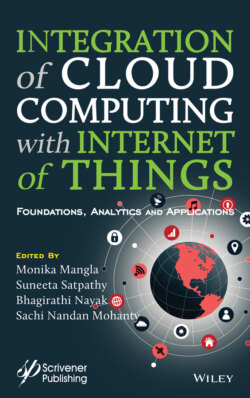Читать книгу Integration of Cloud Computing with Internet of Things - Группа авторов - Страница 29
1.5.4 Semantic IoT vs Machine Learning
ОглавлениеThe Machine Learners (MLs) are essential components in the field of pattern recognition, classification, and regression analysis. Over the years, several MLs have been efficiently applied in the field of power management, speech, and speaker identification, emotion recognition, etc. [28–32]. The integration and coordination of SIoT with MLs has been often discussed in the literature involving pervasive and ubiquitous computing, ambient intelligence, wireless sensor networks, artificial intelligence, human–computer interaction, cognitive science, etc. The multi-layered back-propagating Neural Networks have been effectively utilized to identify human movements such as sitting, walking, running, etc. in smart home applications. Similarly, identification ML models such as the Naive Base Classifiers, Bayesian networks, Support Vector Machines, K-Nearest Neighbor, Hidden Markov Model, etc. have been efficiently applied in the field of context-aware search systems, home automation, navigation systems, etc. in IoT domains.
The Integration and coordination of SIoT and MLs arguably increase the financial health of an industry or business. It requires the choice of specific words or vocabularies to suitably represent a set of concepts. The choice aims to bridge the semantic gap that exists among machines in IoT platform. However, many industries in the existing structure act superficially, thus unable to transform the company into a true profit-oriented entity in reality. For example, the inclusion of Artificial Intelligence in a fast-food chain allows the planning of the diet charts based on the recommendation of user habits. It helps to suggest add-on items based on the current selection, the restaurant traffic, or environmental conditions, weather, or time of a day. The integration of artificial intelligence, SIoT, machine learning, modern analytic models, etc. requires to be embedded with the lifecycle of a customer frequently and completely. For example, the satisfaction level of a customer can be enhanced by displaying his or her name, preferences, frequent visits, etc. on the menu chart makes the client feel proud and special. Efficient handling of a customer’s behaviors, interests, and future intentions can provide many intelligent inputs to the food industry in real-time. Similarly, the AI-powered chat-bouts help the customers with the user-friendly experience to boost revenue due to personalization. It has been observed that most of the consumers are motivated to choose a product of a company that recognizes, remembers, and values his or her association with the product. This way, it is possible to predict a customer’s next move, by upgrading and feeding SI data consistently in an IoT platform. This feedback provides the simulating engines or MLs an edge for new developments in this field with better outcomes. Ultimately, the revenue increases, productivity improves, operational expenses reduced, personalization enhanced at a large scale that leads to better customer experiences. The SI automated IoT embedded machines with intelligence assists millions of smart models functioning concurrently that benefits both the customers and service providers.
